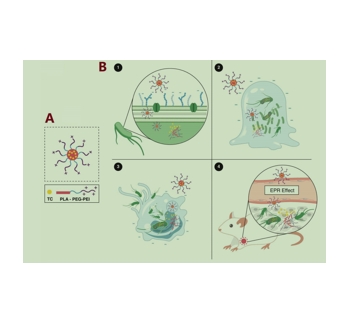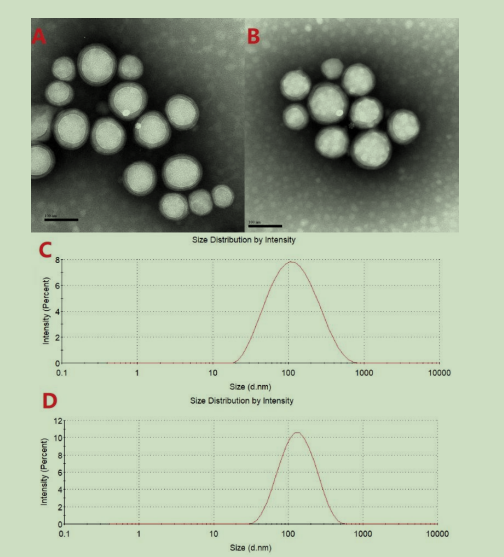文献:Development of Polycationic Micelles as an Efficient Delivery System of Antibiotics Overcoming Biological Barriers to Reverse Multidrug Resistance in Escherichia coli
文献链接:https://pubmed.ncbi.nlm.nih.gov/32412567/
作者:Rong Guoa , Keke Lia , Jing Qinb , Shengli Niuc , Wei Honga
相关产品:
原文摘要:Highly pathogenic Gram-negative bacteria (G- ) are tenacious and pose a serious thread to public health mainly because of three biological barriers, cell envelopes blockage, biofilms protection and macrophages shelter. One strategy used to bypass biological barriers and consequently achieve satisfying G- bactericidal effect is to utilizing polymeric micelles with superior bacterial recognition and binding capabilities. In the current study, we explored the biological barriers penetration ability of a traditional polycationic micellar system (PP-PEI) based on the copolymer of polylactide-poly (ethylene glycol)-polyethylenimine (PLA5K-PEG2K-PEI2K). Subsequently, tetracycline (TC) with good fluorescence property was encapsulated into the PLA core of the micelle (PP-PEI/TC) through hydrophobic interaction. The combination of a PEI shell and loaded antibiotic drug endowed the polycationic micelles with a greater capacity on killing drug-resistant bacteria, destructing biofilms and eradicating intracellular bacteria, compared with free TC and micelles without inoculation of a PEI moiety. The confocal laser scanning microscope (CLSM) and flow cytometry illustrated that PP-PEI/TC could completely penetrated and accumulated in drug-resistant E. coli, biofilms and infected macrophages. The efficient biological barrier penetration was elucidated as the strong electrostatic interactions between the polycationic PEI block and the anionic composition of the bacterial outer membrane (e.g. LPS), macrophage cell membrane (e.g. phospholipid) and extracellular polymeric substances (e.g. eDNA), which was confirmed by biolayer interferometry (BLI). Once the micellar system was bound to a negatively-charged surface, bacterial and cellular enzymes could degrade the PP-PEI core to release its antibacterial content and finally kill planktonic bacteria, bacteria over the depth of a biofilm and/or intracellular bacteria. In vivo imaging indicated that fluorescent polycationic micelles accumulated in bacterial infection sites with strong fluorescence. In vivo antibacterial experiments showed that PP-PEI/TC could dramatically reduce the number of drug-resistant E. coli EB1-1 in the peritoneal cavity of acute peritonitis BALB/c mice compared with its counterparts. In conclusion, our study demonstrated the polycationic micelles with a PEI shell could penetrate into drug-resistant bacteria, biofilm matrix and infected macrophages and led to spatiotemporal release of antibacterial agents for the comprehensive treatment of drug-resistant relevant infections.
PLA-PEG-PEI(聚乳酸聚乙二醇聚乙烯亚胺)是一种三嵌段共聚物,PLA-PEG-PEI的阳离子性质使其能够与细胞膜发生相互作用,实现药物的稳定和内吞。因此,它可以作为药物封装材料,用于制备胶束或囊泡等新型靶向产品。PP-PEI/TC体积较大,尺寸为103 nm,不仅使胶束快速进入bacteria膜、细胞膜和生物膜基质,而且促进胶束在bacteria感染组织中的外渗和积累。PP-PEI/TC表面的PEI层有助于pH 7.4的正电荷,促进穿透生物膜,而阴离子或中性纳米颗粒不能有效穿透。胶束首选的TC释放行为由快速爆发释放和持续释放组成,以避免抗生素耐受性的干扰。

图为:由疏水结合疏水段驱动的聚阳离子胶束的组装针对耐药的大肠杆菌①、生物膜②、受感染的巨噬细胞③和bacteria感染组织的多阳离子胶束示意图
PP-PEI/TC胶束的制备:
PP-PEI/TC:装载TC的PLA-PEG-PEI组成的多阳离子胶束;mPP/TC;PP-PEI/尼罗河红:PLA-PEG-PEI组成的多阳离子胶束;mPP/尼罗河红:装载尼罗河红的PPA-mPEG/DiR:PLA-PEG-PEI组成的多阳离子胶束,装载DiR;mPP/DiR:PLA-mPEG组成的胶束;采用薄膜水化法构建PP-PEI/TC胶束。首先,在甲醇中制备TC溶液,超声处理。在旋转蒸发去除溶剂后得到薄膜,在室温下进一步蒸发以去除膜中的甲醇残留。将薄膜置于PBS中,过滤去除TC聚集体,制备胶束溶液。

图为:mPP/TC (C)和PP-PEI/TC (D)的粒径和分布
结论:本研究采用两亲性共聚物PLA-PEG-PEI自组装为材料,构建了聚阳离子胶束体系。新开发的系统不仅可以用于浮游耐药菌株,还可以用于生物膜和细胞内模式下的bacteria,通过绕过生物屏障,解决了抗菌药物渗透的问题。利用耐药大肠杆菌模型进一步评估了PP-PEI的作用机制,表明其生物屏障穿透能力是由于带正电荷的PEI阻滞和带负电荷的生物屏障成分之间的非特异性静电相互作用。因此,PP-PEI系统也应该适用于其他G菌株,或G+菌株,只要这些菌株有一个带负电荷的表面。此外,PP-PEI/TC能够靶向bacteria感染组织,抑制体内bacteria生长,说明PP-PEI胶束可能是Treatment 耐药感染性疾病的有效途径。

 2024-12-18 作者:lkr 来源:
2024-12-18 作者:lkr 来源:

